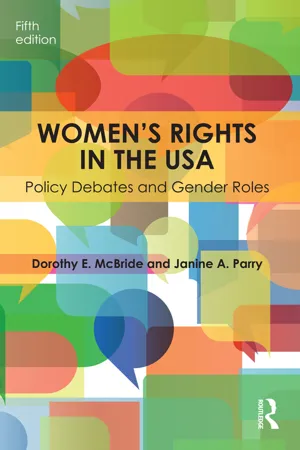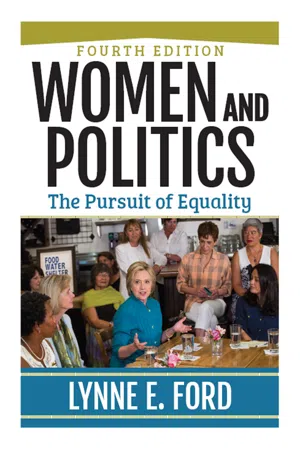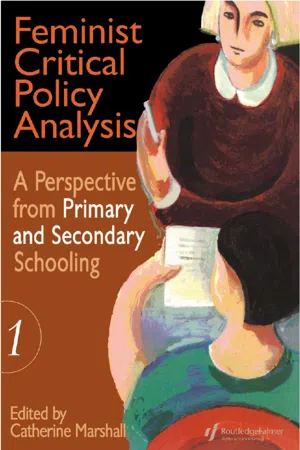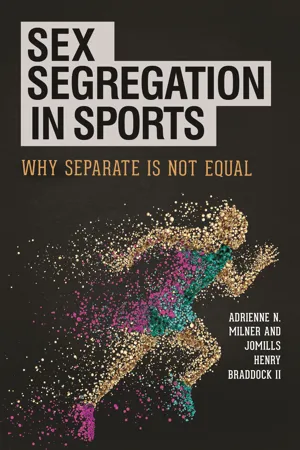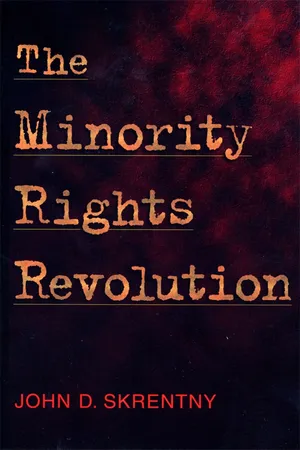History
Education Amendment Act of 1972
The Education Amendment Act of 1972, also known as Title IX, is a federal law in the United States that prohibits discrimination on the basis of sex in any educational program or activity receiving federal financial assistance. It has had a significant impact on promoting gender equality in education, particularly in the areas of athletics and access to educational opportunities.
Written by Perlego with AI-assistance
Related key terms
1 of 5
10 Key excerpts on "Education Amendment Act of 1972"
- eBook - PDF
Badges and Incidents
A Transdisciplinary History of the Right to Education in America
- Michael J. Kaufman(Author)
- 2019(Publication Date)
- Cambridge University Press(Publisher)
4 The most consequential and far-reaching of these bills was Title IX of the 1972 Education Act. As we will see throughout this chapter, Title IX explicitly conditions the continued receipt of federal funds on recipients’ compliance with the command to eliminate sexual discrimination in their institutions. 5 Its language is simple, direct, and far-reaching. Title IX states: No person in the United States shall, on the basis of sex, be excluded from participation in, be denied the benefits of, or be subject to discrimination under any education program or activity receiving Federal financial assistance. 6 This broad command touches every aspect of education, impacting academics, athletics, and student discipline at all educational institutions accepting federal aid, as well as student body composition at public institutions of higher learning. Title IX has proved especially impactful at the university level. While the nearly half century of Title IX’s existence has featured a number of divisive conflicts surrounding its use and interpretation, women’s rights legislation was seen as entirely uncontroversial by both the House and the Senate in 1972. As Freeman ironically notes: “Support for (the Equal Rights Amendment) came from an extraordinarily broad spectrum of national figures from actress Jane Fonda . . . to Richard Nixon and Strom Thurmond.” 7 Given the many battles over the appro- priate scope and usage of Title IX, it is revealing to discover that the basic premise of Title IX enjoyed such an extraordinarily wide consensus at its inception. THE PARAMETERS OF TITLE IX: BROAD SCOPE, JUDICIAL PRECEDENTS, AND ADMINISTRATIVE REMEDIES In the Education Amendments of 1972, 8 Congress included Title IX’s directive preventing gender-based discrimination in federally 2 Ibid. at 262–265. 3 Ibid. at 264. 4 Ibid. 5 Ibid. 6 United States Department of Justice, “Equal Access to Education: Forty Years of Title IX” (June 23, 2012), 1. - eBook - ePub
Gender in the Classroom
Foundations, Skills, Methods, and Strategies Across the Curriculum
- David Sadker, Ellen S. Silber(Authors)
- 2016(Publication Date)
- Routledge(Publisher)
Department of Education, 2006). The law also covers institutions such as vocational training centers, public libraries, and museums. It was intended to ensure equal opportunity for women and girls in all aspects of education—from access to higher education to equal opportunities and fair treatment in elementary and secondary classrooms to equal opportunity in athletics. In this chapter, you will have the opportunity to understand the letter of the law—the legal requirements of Title IX—as well as to embrace the spirit of Title IX—a broader notion of equity that integrates gender with related issues of race, culture, disability, ethnicity, sexual orientation, and socioeconomic status. Access, achievement, and equity—isn't that what educational excellence is all about? WHAT WE KNOW A Look Back: The Beginning of Title IX. In 1970, Representative Edith Green and Senator Birch Bayh drafted legislation prohibiting sex discrimination in education and held the first congressional hearings on the education and employment of women. The original version of the bill proposed to amend Title VII of the 1964 Civil Rights Act (prohibiting discrimination in employment on the basis of race, color, religion, sex, or national origin) to cover employees in educational institutions. The measure also proposed to amend Title VI of the Civil Rights Act (prohibiting discrimination on the basis of race, color, or national origin in any program receiving federal financial assistance) to cover sex discrimination and to extend the Equal Pay Act to cover executives, administrators, and professionals. Honoring the requests of Black leaders and their supporters, who feared that the process of amending Title VI could weaken its coverage, Representative Green proposed a separate and new title, which became the now famous Title IX. Congress passed the bill on June 8, 1972 - eBook - PDF
Women Cross-Culturally
Change and Challenge
- Ruby Rohrlich-Leavitt(Author)
- 2011(Publication Date)
- De Gruyter Mouton(Publisher)
Legislation: An Aid in Eliminating Sex Bias in Education in the United States KATHRYN G. HEATH Encouraging today is the growing realization in many parts of the world that discrimination against girls and women, like discrimination on the grounds of race, color, religion, or national origin, works to the disadvan-tage of society as a whole. Those discriminated against bear unnecessary burdens and scars, while the discriminators, in turn, end up with some unnecessary burdens and scars of their own. In addition, the Nation is deprived of the skills and talents of many people. Encouraging, too, is the abundant historical evidence that a day of reckoning eventually comes. For education, that day is at hand across the length and breadth of the United States of America. American Education, an official popular voice in its field and the official journal of the Nation's Office of Education, puts it this way: ...change in customary ways of doing things, change of revolutionary propor-tions, is now enveloping education at every level. At its core is the issue of women's rights — and more paricularly three pieces of Federal legislation that have made 1972 a climactic historical date in the drive by women for treatment in education equal to that afforded men (Dorr 1972:5). Looking back over the years for perspective reveals certain early events that determined the location of education power within the Nation and that have had continuing influence on related Federal legisla-tive action. Various later events played their parts in the gradual devel-opment in education as well as in other fields of a climate that is more favorable to remedial and constructive action on behalf of girls and wo-men and is beneficial to all. 328 KATHRYN G. HEATH EDUCATION POWER Puritan colonizers arriving in the New World in the seventeenth cen-tury believed that the people should determine for themselves how their children were to be instructed and reared. - eBook - ePub
Women's Rights in the USA
Policy Debates and Gender Roles
- Dorothy E. McBride, Janine A. Parry(Authors)
- 2016(Publication Date)
- Routledge(Publisher)
Grove City College was in force. But what is clear is that policy to achieve sex equity in education is uneven and that there have been recurring efforts to limit, rather than expand, enforcement.It is worth noting that sometimes the most important effect of the federal education laws seems to be that they spur the activism of interest groups in working with local schools and universities to promote equal opportunity. Untold numbers of school districts, for example, likely have complied with Title IX regulations under pressure from local branches of the AAUW in particular, a group which continues to press for Title IX-related data collection and reporting for public schools. Patterns of compliance are likely to remain uneven in the hyper-federated world of education policy. But, decades after its adoption, the effect of even an often-hampered Title IX is clear: recent analyses point to a direct, and markedly positive, effect for girls’ athletic participation on the educational, economic, and health prospects of the women they become (Stevenson 2010 ; Kaestner and Xu 2010 ).Other Gender Equity Policies in Education
Women's Educational Equity Act, 1974
“A program with no director, with a staff of one and one-quarter persons located in two different offices of the Department of Education and operating under threat of extinction for a decade.” Such was the U.S. General Accounting Office's assessment of the Women's Educational Equity Act (WEEA) in 1994. WEEA was enacted in 1974 in the wake of Title IX. While Title IX was primarily a regulatory law—setting forth requirements and prohibitions to end sex discrimination—WEEA was its substantive counterpart. It has authorized funds to assist educators to develop non-sexist materials and textbooks, to change programs of teacher training, to support research, and to develop bias-free counseling materials. It established a women's policy office—the National Advisory Council on Women's Educational Programs—at the Department of Education that was responsible for overseeing the gender-equity policy. - eBook - ePub
Women and Politics
The Pursuit of Equality
- Lynne Ford(Author)
- 2018(Publication Date)
- Routledge(Publisher)
Why educate women? Although this question may sound rhetorical today, in many countries and in some subcultures of the United States, education is still reserved almost exclusively for males, or after a certain level is limited to males. Girls in Afghanistan and Pakistan are the target of acid attacks and other forms of physical intimidation to dissuade them from going to school. Women’s access to education in professional programs and in some institutions had been limited until Title IX, which was passed in 1972 as an amendment to the 1964 Civil Rights Act. Designed to address questions of gender equity in education by banning discrimination based on sex, Title IX receives the most public attention for what it has meant to girls’ and women’s athletics.The American Association of University Women (AAUW) put the issue of gender equity in the classroom squarely before the public by issuing How Schools Shortchange Girls, a major research study that documented how girls were being unfairly disadvantaged by common classroom practices that gave preference to boys and valued boys over girls. Critics have charged that the situation is quite the opposite: rather than schools cheating girls, as the AAUW report charged, boys are now at a disadvantage and are suffering from discrimination in education.1 We will evaluate both arguments in this chapter. Finally, education is such a fundamental resource that its long-term influence is felt throughout a person’s lifetime. We will examine the effect of education or the lack of it on women’s status in the United States. The chapter concludes with an examination of issues in education facing future generations of citizens and policy makers.A BRIEF HISTORY OF THE EDUCATION OF WOMENEducation by its very nature empowers individuals, cultures, and nations to survive. From the beginning of human existence, informal education provided essential information about how to find and prepare food, build shelter, heal the sick, give birth to new life, and mourn the dead.2 Access to formal education throughout time and regardless of place has been a restricted privilege. In ancient Greece, for example, athletics, music, and reading were the formal educational requirements for young males destined for full membership in the citizen class. By the Middle Ages, daughters of royalty were sometimes tutored, but it was not until the nineteenth century that even a few men beyond royalty received a formal education. “Formal education was considered irrelevant for most free citizens, dangerous for men of lower status and for women, and even illegal for enslaved black people.”3 - Available until 4 Dec |Learn more
- Catherine Marshall(Author)
- 2005(Publication Date)
- Routledge(Publisher)
A technocratic explanation of state behavior would be that the implementation of complex innovations needs certain preconditions to be successful—especially a clear description of the innovation and, in this case, a large number of personnel trained in gender analysis and project design and implementation. Along these lines, the gender equity legislation failed essentially because the bureaucracy was not prepared to act efficiently and effectively. But the trajectory of Title IX and WEEA suggests that weaknesses lay elsewhere. A more political explanation is that governments support a male-dominated social order and are thus unlikely to strongly support attempts to transform gender relations. Current legislation for women in education has been characterized by weakness in three key areas: the content and scope of the laws, funding levels to enable adequate implementation, and enforcement mechanisms to ensure that educational organizations will comply with the law. Considering the resources in place, those interested in the improvement of women’s conditions have reason to suspect that the federal government lacks a strong willingness to alter the status quo in society.The federal government (or the state, in a more abstract sense) plays a role as a key mediating agency between women and social change. In the case of the educational legislation reviewed herein, it seems that the state, being unable to reject outright the concerns of a sizable segment of the American population, passed a series of legislative measures to address gender equity in education. At the same time, it used other means to render the laws largely ineffective. The two pieces of educational legislation examined in this chapter left untouched critical elements that could have contributed to social restructuring. Title IX discouraged sex discrimination but monitoring and enforcement were deficient. It did not address the content of textbooks nor that of courses.Surprisingly, it is in the area of sports that Title IX seems to have been most effective. The increased presence of women in previously male-dominated terrains is a highly positive development and will result in the effective demolition of many sexual stereotypes—as already reflected in the 1996 Olympics. WEEA expressed in principle the possibility of introducing new content, such as a gender-equitable sexual education program, so that social relations could be redefined. It also provided for the training of teachers. Yet the levels of WEEA funding did not enable large numbers of teachers to undergo training in gender issues; WEEA merely opened up the possibility that the few who asked for help would receive it. WEEA funds also covered a very limited number of new gender-sensitive programs. The Title IX and WEEA policies were designed to have limited impact on the hidden curriculum of schools, so such issues as sexual harassment by teachers and student peers, stereotyped and negative expectations by teachers, and counseling/preparation for nonconventional fields of study were given minimal attention. By design, WEEA relied on voluntary efforts, but voluntary equity programs are unlikely to be very successful in promoting macrosocial change. They encourage, for the most part, only those already inclined to change and provide limited funds for the various needs to be satisfied. - eBook - ePub
Birch Bayh
Making a Difference
- Robert Blaemire(Author)
- 2021(Publication Date)
- Indiana University Press(Publisher)
We are all familiar with the stereotype of women as pretty things who go to college to find a husband, go on to graduate school because they want a more interesting husband, and finally marry, have children, and never work again. The desire of many schools not to waste a “man's place” on a woman stems from such stereotyped notions. But the facts absolutely contradict these myths about the “weaker sex” and it is time to change our operating assumptions . . . While the impact of this amendment would be far-reaching, it is not a panacea. It is, however, an important first step in the effort to provide for the women of America something that is rightfully theirs—an equal chance to attend the schools of their choice, to develop the skills they want, and to apply those skills with the knowledge that they will have a fair chance to secure the jobs of their choice with equal pay for equal work.Title IX comprises a total of thirty-seven words: “No person in the United States shall, on the basis of sex, be excluded from participation in, be denied the benefits of, or be subjected to discrimination under any education program or activity receiving Federal financial assistance.”10 Undeniably it is a sweeping concept, but it received little public attention at the time.Birch had been taught that boys and girls should be treated the same. He recalled a breakfast when living in the DC area before high school. His father, then working in the DC public school system, told his sister and him that he was going to testify before Congress that day. He was going to tell them they needed to fund girls’ physical education. “They need strong bodies too.”Rep. Patsy Mink of Hawaii introduced Title IX in the House, and it became law on June 23, 1972. Lee Hamilton remembered when Birch was promoting Title IX and was resolved to do what he could to help it pass in the House. Because of her substantial abilities, Lee was glad to see Patsy Mink shepherding it there.11 Rep. Edith Green of Oregon had tried to do the same thing in previous years but had been unsuccessful. When President Nixon signed the Higher Education Act, he spoke mostly about another focus of the bill, desegregated busing, and never mentioned Title IX, which was enacted with his signature. In the early years after Title IX’s birth, few people had even heard of it. Most people today are aware of it only as it applies to women’s sports. It may have created organized women’s sports, but the law addresses ten key areas. These are “access to higher education, career education, education for pregnant and parenting students, employment, learning environment, math and science, sexual harassment, standardized testing and technology.”12 - eBook - ePub
Sport Marketing in a Global Environment
Strategic Perspectives
- Ruth M. Crabtree, James J. Zhang, Ruth M. Crabtree, James J. Zhang(Authors)
- 2022(Publication Date)
- Routledge(Publisher)
The Department of Education created the amendments of Title IX in 1972 to prohibit discrimination based on gender in any program of education or federal funded activity (OCR, 2015), which resulted in a nationwide revolution in the treatment of women in collegiate athletics. Part of Title IX reads:No person in the United States shall, on the basis of sex, be excluded from participation in, be denied the benefits of, or be subjected to discrimination under any education program or activity receiving Federal financial assistance(OCR, 2015).In other words, Title IX prohibits gender discrimination in educational institutions supported by federal funds in the United States – including high-schools, colleges, and universities (Walters & McNeely, 2010). By the law, the institutions were required to not only assign a Title IX coordinator to manage discrimination claims in educational programs but also publish guidelines for employees and students.After Title IX was signed into law in 1972, the legislative and political debates focused on applicability to sport, in particular, football and intercollegiate sports (Stevenson, 2007). However, many opponents of Title IX had concerns about the fiscal implications of equal spending on male and female sports and tried to weaken this requirement through an amendment to exempt “revenue-producing” sports (Kahn, 2007; Stevenson, 2007). Ultimately, these amendments were not applied. The final regulations of Title IX were released in 1975, and federally funded institutions had to be compliance by 1978 (Stevenson, 2007). The rules indicated that female students could try out for male teams if an institution did not have a female team and required setting up equipment and making facilities available for female students.However, due to a potential fiscal burden to the institutions, another three-pronged test replaced these rules (Stevenson, 2007). The three-pronged test required institutions to provide equal opportunity to male and female students, rather than focusing on a single compliance standard. By the law, institutions must (1) provide equal sport participation rates between male and female students, (2) demonstrate a history of expansion of the female athletic programs, and (3) meet the demand of female students (Li et al., 2009; Stevenson, 2007). - eBook - ePub
Sex Segregation in Sports
Why Separate Is Not Equal
- Adrienne N. Milner, Jomills Henry Braddock II(Authors)
- 2016(Publication Date)
- Praeger(Publisher)
CHAPTER TWO Title IX History, Results, and Controversies of “Separate but Equal”The civil rights movement and the women’s movement have spawned decades of debate on the concept of equality. Sometimes the answers have been glaringly obvious; other times they have been elusive. In the early days of these movements, discrimination was often blatant, with jobs reserved for only whites or only men. Such explicit, facial distinctions have all but vanished in the face of constitutional claims … One significant exception, however, is sports, where we continue to accept, expect, and even defend sex segregation as the status quo.—B. Glenn George 1BackgroundSocial justice legislation is never conceived or established in a vacuum, and Title IX emerged in the context of domestic, international women’s, and civil rights movements. Feminists in the United States, like U.S. civil rights activists, made discrimination and equality the major political issues. Thus, the passage of Title IX and the Women’s Educational Equity Act of 1974 (WEEA), which provided programmatic funding to implement many of the principles set forth in Title IX2 —like Brown v. Board of Education and the civil rights legislation of the 1960s—represented major achievements for social justice advocates seeking an end to the systemic inequities that permeated the U.S. educational system.3Title IX was intended to address broad societal sex disparities rooted, at least in part, in educational inequities. For example, before Title IX, sex stereotypes in school textbooks defined very limited “gender appropriate” roles for girls. Indeed, the textbook roles typically defined as appropriate for girls, constrained their access to mathematics and science courses in high school, STEM majors in college, and scientific careers in adulthood. Sex sorting in schools affected female opportunities at every level of education. Even in high school vocational programs, most girls could only take courses that trained them for such low-wage, traditionally female jobs as cooks or cosmetologists, not such better paying “male” jobs as mechanics or electricians. In addition, teenage girls who became pregnant often faced expulsion from school because of the prevailing social norms. Before Title IX, female educators mainly taught in elementary and secondary schools and women had very few faculty or administrative opportunities in higher education. Girls and women also had little recourse for addressing sexual harassment in all its varied forms. Sex bias in standardized testing resulted in lower female performance. Females’ access to computer technology and technical training was also limited by gender stereotypes in a society that defined technology as a masculine, and thus exclusively male, domain. - eBook - PDF
- John D. Skrentny, John David Skrentny(Authors)
- 2009(Publication Date)
- Belknap Press(Publisher)
A s s hown in Chapter 9, an extremely ob s cure Labor Department regulation for affirmative action for white ethnic s wa s s topped dead in it s track s . Fur-thermore, the Nixon admini s tration s upported the principle behind Title IX, a s evidenced by the s upport given at Edith Green’ s 1970 hearing s . But it i s al s o true that Nixon almo s t certainly never thought deeply about what Title IX would mean, and later called it a “ mon s tro s ity. ” 65 S till, the Nixon team wa s clearly di s tracted by a s pect s of the Education Amendment s of 1972 having to 248 248 The Minority Rights Revolution do with bu s ing of black and white s chool children to achieve racial integra-tion. Nixon’ s June 23 s igning s tatement doe s not mention women’ s right s at all. He lauded the bill’ s financial aid program for college loan s and grant s and the e s tabli s hment of a new National In s titute of Education within HEW for re s earch on compen s atory effort s for more equality in education. The bulk of hi s s tatement regarded the bill’ s “ inadequate, mi s leading and entirely un s at-i s factory ” antibu s ing provi s ion s . Nixon wanted re s triction s , s tandard s , and uniformity in court-ordered bu s ing, but he believed Congre ss only offered rhetoric. He complained, “ not in the cour s e of thi s admini s tration ha s there been a more manife s t congre ss ional retreat from an urgent call for re s pon s i-bility. ” 66 But he wa s not referring to the complete lack of exploration of the meaning of women’ s equality in education. Like s o many a s pect s of the mi-nority right s revolution, in the ca s e of women’ s equality in education, the revolution took place while no one wa s watching. Preserving the Law: The Discovery of Difference Title IX would have little impact until there were regulation s s tating what forbidding s ex di s crimination in education meant. It wa s during thi s proce ss that the analogy with black s faltered.
Index pages curate the most relevant extracts from our library of academic textbooks. They’ve been created using an in-house natural language model (NLM), each adding context and meaning to key research topics.



